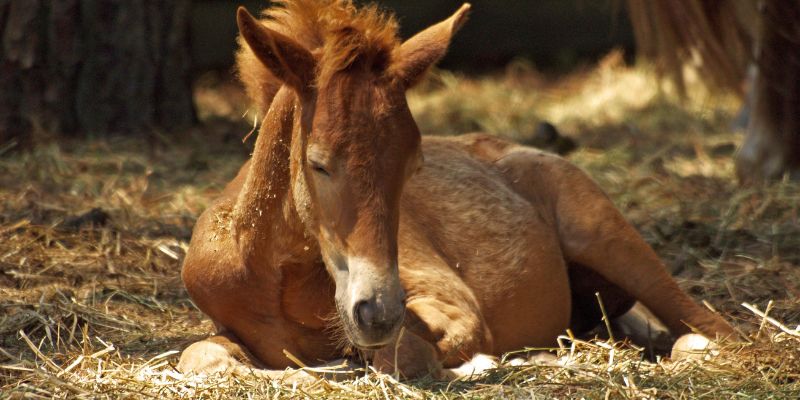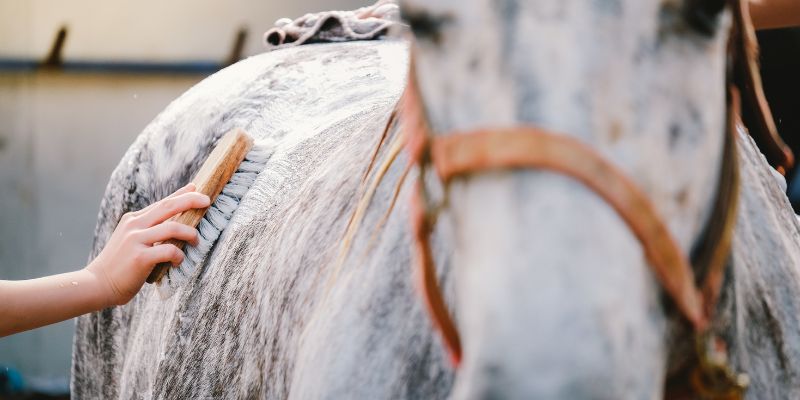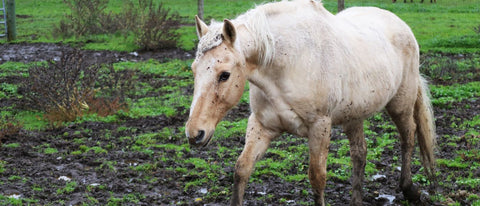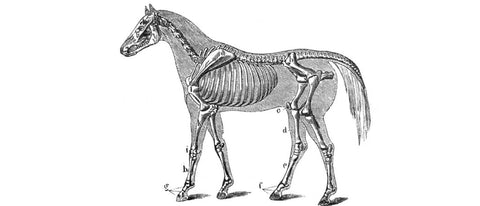
Florian ist aufgewachsen auf einem Bauernhof. Umgeben von Pferden, entdeckte er früh seine Faszination für diese majestätischen Tiere. Inspiriert von seiner reitbegeisterten Mutter, entwickelte er das Nahrungsergänzungmittel - Pferdegold. Seine tiefe Verbundenheit zur Natur und die leidenschaftliche Hingabe zu Pferden trieben ihn an, sein Unternehmen zu gründen.
At Pferdegold, we are passionate about the health and well-being of our horses.
Cushing's syndrome in horses requires special attention and understanding, whether for information or for active management of this disease.
In this guide, we shed light on what Cushing's disease means in horses, explore treatment options, and share our best tips and tricks for caring for and feeding your horse with Cushing's disease.
Our goal is to support you so that you can make the best possible decisions for the well-being of your horse.

Cushing's syndrome in horses: What's behind it?
Cushing's syndrome in horses, often referred to as equine Cushing's syndrome (ECS) or pituitary pars intermedia dysfunction (PPID) , is a disease that primarily affects older horses.
Incidentally, Cushing's syndrome owes its name to the neurosurgeon and physician Harvey Cushing, who first described the disease in humans, but in horses it takes on a unique form.
It is a hormonal disorder that has profound effects on the health and well-being of affected animals.
Understanding this disease is crucial because it affects various aspects of horse health, from coat condition to overall vitality.
Below we will give you an overview of what exactly causes Cushing's disease in horses and what the diagnosis means for horses and their owners.
All causes at a glance
-
Hormonal dysfunction:
Cushing's syndrome in horses is primarily caused by dysfunction of the pituitary gland .
This disorder leads to excessive production of certain hormones, particularly adrenocorticotropic hormone (ACTH), which in turn stimulates the adrenal glands to produce increased cortisol . Risk factors include age, genetic predisposition, and certain environmental conditions.
A direct cause cannot often be identified, but research shows that oxidative stress factors and neurodegenerative changes in the brain can play a role.
-
Genetic predisposition:
There is evidence that genetic factors, such as a mutation of the USP8 gene, may play a role.
This genetic predisposition makes certain horses more susceptible to developing PPID.
-
Insulin resistance:
Studies suggest that Cushing's syndrome may be a consequence of insulin resistance in some cases, making it a possible sequela of equine metabolic syndrome (EMS). The frequent presence of obesity in horses prior to the onset of the disease supports this theory.

Perfect for your horse: Pferdegold® supplementary feed!
These specially developed supplements support your horse's diet and provide it with natural nutrients. Made in Germany, grain-free and drug-free, they come with a 30-day money-back guarantee.
Try it now!Can hormone imbalances cause Cushing's syndrome in horses?
Yes, hormone imbalances are indeed the main cause of Cushing's syndrome in horses.
The disease is the result of an overactive pituitary gland, which leads to an imbalance in hormone production .
This imbalance causes a number of symptoms and health problems that are characteristic of Cushing's syndrome.
In particular, the overproduction of ACTH leads to an increase in cortisol levels in the blood, which has far-reaching effects on the horse's body and causes the typical symptoms of ECS.
Symptoms and first signs
Recognizing the symptoms of Cushing's syndrome is crucial for early diagnosis and appropriate treatment.
The disease manifests itself through a number of symptoms, some of which can significantly impair the horse's well-being.
-
Altered coat: One of the most noticeable symptoms in Cushing's disease is a long, curly coat that is not seasonal and sheds poorly. This can lead to a dense coat that lasts year-round.
-
Muscle atrophy: Visible muscle atrophy can occur, particularly in the back and hindquarters, which changes the horse's body shape.
-
Laminitis: A serious and potentially life-threatening Cushing's symptom is a tendency to laminitis, an inflammation of the hoof capsule.
By the way, about 70% of laminitis cases in horses are said to be due to Cushing's syndrome.
-
Increased susceptibility to infections: Due to the weakened immune system, horses with Cushing's syndrome have a higher susceptibility to infections , especially of the skin and respiratory tract.
-
Abnormalities in water balance: Increased thirst and more frequent urination can be typical symptoms of Cushing’s disease.
- Behavioral changes: Lethargy or changes in interaction with people and other horses can also be signs.
Particularly in the final stages of Cushing's disease, these symptoms can become more pronounced and make the management of the disease more complex and challenging.

Treatment: What really helps?
Although Cushing’s syndrome in horses is not curable, there are effective treatment options,
which can alleviate symptoms and improve the quality of life of affected animals.
✔ Drug therapy
The most commonly used drug is pergolide, a dopamine receptor agonist.
It helps regulate the excessive hormone production of the pituitary gland and thus improves the symptoms of ECS .
However, the dose of pergolide must be carefully adjusted and regularly adjusted based on the horse's blood values. Regular veterinary monitoring is therefore essential.
✔ Nutrition management
A balanced diet supports the horse's overall well-being and can help slow the progression of the disease.
An adapted diet low in sugar and starch plays a crucial role in the treatment of ECS.
Fructan-rich feeds such as certain grasses and hays should be avoided. Special feeds for horses with ECS are available on the market that meet these dietary requirements.
✔ Supportive measures
Regular exercise is crucial to slow the muscle loss associated with the disease and promote the horse's overall well-being.
However, horses with ECS should not be overtaxed and should always be adapted to the individual condition of the horse.
Careful hoof care is also an important factor in Cushing's disease. Due to the increased risk of laminitis in horses with ECS, careful and regular hoof care is essential.
In addition, coat care plays an important role, as horses with Cushing's disease often have problems with shedding and can develop a long coat that requires special attention.
Close cooperation with a veterinarian is crucial to ensure appropriate treatment and monitoring of the affected horse.
Expert tips for feeding Cushing's horses
Proper feeding of horses with Cushing's syndrome (ECS) is an essential part of treatment and care .
Here are some expert tips on how to optimally feed your horse:
What should be avoided?
High-sugar and starchy feeds: To minimize the risk of insulin resistance and laminitis, which are often associated with Cushing's disease, feeds with high sugar and starch content should be avoided. These include:
- Cereal products,
- Molasses,
- Syrup,
- Pomace and
- Juicy food such as carrots,
- Apples and
- Bananas.
Access to fresh pasture grass, which is rich in sugar and fructan, should also be limited.
Recommended food
-
Feed rich in crude fiber and protein: High-quality hay with a low sugar content should form the basis of the feed.
If necessary, alfalfa, green oats, beet pulp and flax or soy products can be added to meet protein and energy requirements.
-
High-quality mineral feed: An adequate supply of minerals and key nutrients, including essential amino acids, is important for Cushing's horses.
- Pay attention to the quality of the mineral feed and ensure that the minerals and trace elements supplied are easily absorbed.
-
Support of the immune system: An adequate supply of natural vitamin E, selenium and vitamin C is important.
Natural sources of vitamin C such as rose hips and parsley can be supportive.
It is also helpful to include unsaturated fatty acids, which are found in flaxseed and black cumin, in the diet, as they may have anti-inflammatory properties.
-
Individual adaptation: When feeding Cushing horses, it is important to adapt the nutrient requirements individually.
For horses with weight and muscle loss, feeds with high fat and protein content but low sugar and starch content should be used.
Overweight horses, on the other hand, should follow a low-energy diet.

Pferdegold® supplementary feed!
Pferdegold is a small family business from Bavaria with a big dream: to produce the best horse feed. We see ourselves as a family of equestrians who want to provide your horse with the ideal nutrition. 100% natural and perfectly tailored to your horse's needs.
Try it now!Cushing's disease in horses: diagnostic methods
The diagnosis of Cushing's syndrome in horses is based on a combination of observation of clinical signs and specific tests.
Veterinarians perform a comprehensive history and physical examination and use blood tests to support the diagnosis.
These tests aim to identify changes in hormone production that may indicate dysfunction of the pituitary gland , a key gland in the brain that plays a central role in the body's hormonal system .
Early testing for horses
Early detection through testing is crucial for effective treatment of Cushing's syndrome.
Blood tests specifically designed for Cushing's syndrome blood levels measure hormones such as ACTH to detect abnormalities.
These hormone levels provide information about the activity of the pituitary gland, whose overactivity is characteristic of Cushing's syndrome.
Close monitoring of these values enables targeted treatment and can help slow the progression of the disease.
How common is Cushing's disease in horses over 15 years old?
Cushing's syndrome is quite common in older horses, especially those over 15 years of age . It appears that a significant proportion of this age group may exhibit signs of this disease.
As horses age, the likelihood of developing Cushing's disease increases, highlighting the importance of early diagnosis and treatment to maintain their quality of life.

Conclusion
As you read this guide, you may have realized that Cushing's syndrome in horses is a serious diagnosis, but with love, care, and the right tools, it can often be managed.
Pferdegold accompanies you on this journey with expert tips that can support your horse and promote its vitality day after day .
Remember to look for signs of Cushing's syndrome early and work closely with your veterinarian to achieve the best possible outcome for your horse.
FAQ
Can a horse with Cushing's syndrome go out to pasture?
Yes, horses with Cushing's syndrome are generally allowed to go out to pasture, but access to fresh grass should be limited.
High sugar content in grass can exacerbate problems such as insulin resistance in Cushing's disease horses. Individual adjustment and monitoring by the owner or veterinarian is recommended.
How long can a horse live with Cushing's disease?
The life expectancy of a horse with Cushing's syndrome can be quite high with proper treatment and care.
Early detection and appropriate management of the disease play a crucial role in improving the quality of life and maintaining vitality for as long as possible.
What happens if Cushing's disease is not treated?
Untreated Cushing's syndrome can lead to deteriorating health, including laminitis, susceptibility to infection, and muscle wasting.
The progressive symptoms can significantly impair the horse's quality of life and lead to further, more serious health problems.
IMPORTANT:
Pferdegold is not a substitute for veterinary diagnosis or treatment . The information contained in this article is for general informational purposes only and is intended to help improve your horse's well-being.
Pferdegold products do not treat or cure diseases , but rather support your horse in correcting nutritional deficiencies through targeted nutrient intake. However, they are not a substitute for professional advice from a veterinarian or specialist.
If your horse has any health problems , we strongly recommend consulting a veterinarian . Pferdegold assumes no liability for decisions made based on the information provided here.
Learn more about horse health and read the next guides!

















